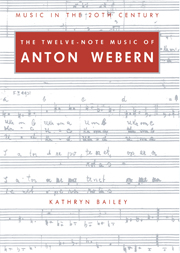Book contents
- Frontmatter
- Contents
- Acknowledgements
- Conventions in the text
- Introduction
- PART I Row and canon
- PART II The instrumental music
- Introduction to Part II
- 4 The movements in sonata form: Opp. 20/ii, 21/i, 22/i, 24/i and 27/i
- 5 The movements in variation form: Opp. 21/ii, 24/iii, 27/iii, 28/i and 30
- 6 The movements in rondo and ternary forms: Opp. 20/i, 22/ii, 24/ii, 28/ii and 28/iii
- 7 The movement in binary form: Op. 27/ii
- PART III The music with voices
- Conclusion
- Appendices
- Notes
- Glossary
- Chronological worklist
- Select bibliography
- Index
6 - The movements in rondo and ternary forms: Opp. 20/i, 22/ii, 24/ii, 28/ii and 28/iii
Published online by Cambridge University Press: 23 December 2009
- Frontmatter
- Contents
- Acknowledgements
- Conventions in the text
- Introduction
- PART I Row and canon
- PART II The instrumental music
- Introduction to Part II
- 4 The movements in sonata form: Opp. 20/ii, 21/i, 22/i, 24/i and 27/i
- 5 The movements in variation form: Opp. 21/ii, 24/iii, 27/iii, 28/i and 30
- 6 The movements in rondo and ternary forms: Opp. 20/i, 22/ii, 24/ii, 28/ii and 28/iii
- 7 The movement in binary form: Op. 27/ii
- PART III The music with voices
- Conclusion
- Appendices
- Notes
- Glossary
- Chronological worklist
- Select bibliography
- Index
Summary
Webern turned to rondo form on only two occasions in his twelve–note music, both during the earlier years. This may be unexpected, in view of his professed admiration for and affinity with the early and middle works of Beethoven, where this form occurs frequently. Both Webern's rondos are seven–part forms: ABA C ABA, Schoenberg's ‘large Rondo form’. Although this is a classical format, neither is a classical rondo. The first, in Op. 20, is a slow movement, not surprisingly calling to mind Beethoven's occasional use of rondo form for a central movement in a slow tempo. (Although it now stands first, the Op. 20 rondo was originally intended as the second of three projected movements.) In keeping with the rather conventional nature of Op. 20 generally, the structural outlines of the rondo are easily identified in the score; even though the refrain is much varied upon its returns, each structural unit is distinguished by characteristic rhythmic figures, tempo and articulation. I think that the contrast of these features between refrain and episodes makes the form relatively clear aurally, as well, though I must admit some impressive opposition to this view. Stravinsky is quoted as saying of this movement: ‘the music is marvelously interesting, but no one could recognize it as a rondo’. Roger Smalley's concurrence with this judgement has already been noted on pp. 155–6. The second rondo, in Op. 22, is longer and more diverse, and much less clear structurally, in the score as well as to the ear. It is here that one is made aware of the difficulty inherent in composing a form that depends on repetition in a style where it is practically forbidden.
- Type
- Chapter
- Information
- The Twelve-Note Music of Anton WebernOld Forms in a New Language, pp. 237 - 261Publisher: Cambridge University PressPrint publication year: 1991



